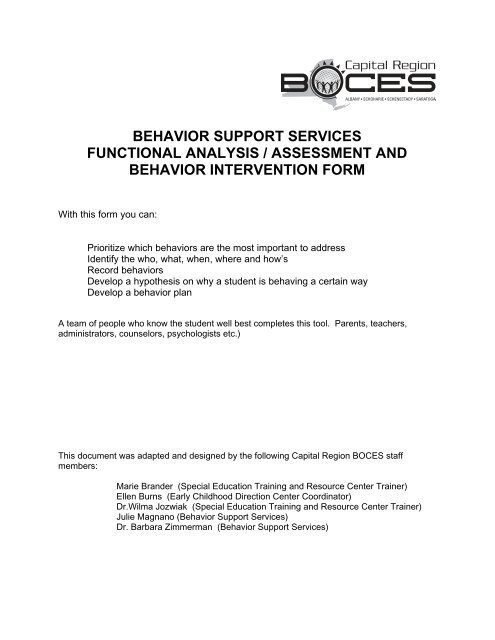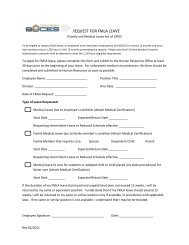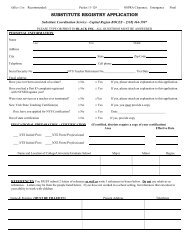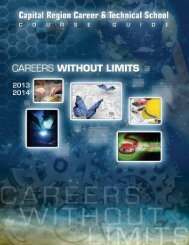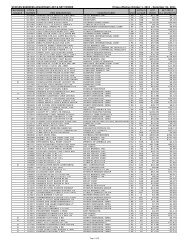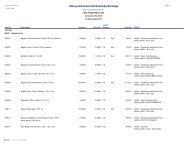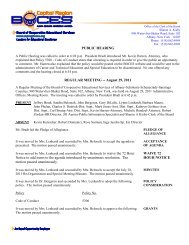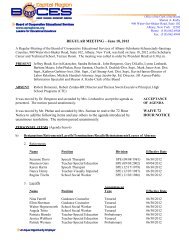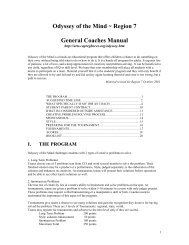Functional Analysis Assessment/Behavior Intervention (PDF)
Functional Analysis Assessment/Behavior Intervention (PDF)
Functional Analysis Assessment/Behavior Intervention (PDF)
You also want an ePaper? Increase the reach of your titles
YUMPU automatically turns print PDFs into web optimized ePapers that Google loves.
BEHAVIOR SUPPORT SERVICES<br />
FUNCTIONAL ANALYSIS / ASSESSMENT AND<br />
BEHAVIOR INTERVENTION FORM<br />
With this form you can:<br />
Prioritize which behaviors are the most important to address<br />
Identify the who, what, when, where and how’s<br />
Record behaviors<br />
Develop a hypothesis on why a student is behaving a certain way<br />
Develop a behavior plan<br />
A team of people who know the student well best completes this tool. Parents, teachers,<br />
administrators, counselors, psychologists etc.)<br />
This document was adapted and designed by the following Capital Region BOCES staff<br />
members:<br />
Marie Brander (Special Education Training and Resource Center Trainer)<br />
Ellen Burns (Early Childhood Direction Center Coordinator)<br />
Dr.Wilma Jozwiak (Special Education Training and Resource Center Trainer)<br />
Julie Magnano (<strong>Behavior</strong> Support Services)<br />
Dr. Barbara Zimmerman (<strong>Behavior</strong> Support Services)
STEP 1: TARGETING SPECIFIC BEHAVIORS<br />
List behaviors/concerns below. Rate each and prioritize which behavior to work on first.<br />
(The most intrusive behaviors should always be targeted first.)<br />
1. __________________________________________ _____(Destructive)<br />
__________________________________________<br />
__________________________________________<br />
_____(Disruptive)<br />
_____(Distracting)<br />
__________________________________________<br />
__________________________________________<br />
2. __________________________________________ _____(Destructive)<br />
__________________________________________<br />
__________________________________________<br />
_____(Disruptive)<br />
_____(Distracting)<br />
__________________________________________<br />
__________________________________________<br />
3. __________________________________________ _____(Destructive)<br />
__________________________________________<br />
__________________________________________<br />
_____(Disruptive)<br />
_____(Distracting)<br />
__________________________________________<br />
__________________________________________<br />
For example:<br />
Destructive (hitting, hurting others)<br />
Disruptive (disturbs materials, provokes others)<br />
Distracting (loud noises, noncompliance)<br />
2
STEP 2: ANSWERING KEY QUESTIONS<br />
HOW OFTEN DOES THE BEHAVIOR OCCUR?<br />
Per hour?____ Per day?____ Per week?_____<br />
How long does the behavior occur per episode?<br />
Is there a time, place, or person that seems to decrease the behavior?<br />
Who is present when the behavior occurs?<br />
ANTECEDENTS<br />
What is going on when the behavior occurs?<br />
When does the behavior tend to occur?<br />
When does the behavior tend not to occur?<br />
Where does the behavior tend to occur?<br />
Where does the behavior tend not to occur?<br />
What happens after the behavior occurs?<br />
CONSEQUENCES<br />
What does the staff do?<br />
What do the other students do?<br />
What does the individual who had engaged in the behavior do?<br />
What do you think increases the likelihood of the behavior occurring again?<br />
3
STEP 3: RECORDING BEHAVIORS<br />
When? Describe behavior. What happened before? What happened<br />
Date? after? [intensity, duration and frequency]<br />
Time?<br />
_____________________________________________________________________<br />
_____________________________________________________________________<br />
_____________________________________________________________________<br />
_____________________________________________________________________<br />
_____________________________________________________________________<br />
_____________________________________________________________________<br />
_____________________________________________________________________<br />
_____________________________________________________________________<br />
_____________________________________________________________________<br />
_____________________________________________________________________<br />
_____________________________________________________________________<br />
_____________________________________________________________________<br />
_____________________________________________________________________<br />
_____________________________________________________________________<br />
4
STEP 4: DEVELOP A THEORY<br />
The checklist below is helpful in figuring out the purpose of a specific behavior. Some<br />
behaviors may serve more than one purpose.<br />
The purpose of the behavior may be ATTENTION if it occurs....<br />
• When you are not paying attention to the student (e.g. you are talking to<br />
someone else in the room, or are on the phone.)<br />
• When you stop paying attention to the student.<br />
The purpose of the behavior may be ESCAPE/AVOIDANCE if it occurs....<br />
• When you ask the child to do something that he or she does not seem to like or<br />
want to do. (e.g., complete a task, put materials away)<br />
• The behavior stops after you stop “making demands”<br />
The purpose of the behavior may be GETTING SOMETHING if it occurs....<br />
• When you take away an object or activity.<br />
• It the behavior stops soon after you give the student materials, or the student has<br />
requested an activity that is desirable to the student.<br />
• When the student can not have an object, or activity that has been requested.<br />
The purpose of the behavior may be SELF - REGULATION if it tends....<br />
• To be performed over and over again, in a rhythmic or cyclical manner.<br />
• Happens when there is either many things going on in the area or very little going<br />
on in the area. (e.g., noise, movement, people, activity...)<br />
• The student can still do other things while performing the behavior.<br />
The purpose of the behavior may be PLAY if it tends....<br />
• To be repeated when no one else is around<br />
• To be enjoyed by the student performing the behavior (e.g., smiling, laughing)<br />
• The student cannot do other things while performing this behavior.<br />
THE MAIN PURPOSE OF THIS BEHAVIOR IS:<br />
_____________________________________________________________________<br />
_____________________________________________________________________<br />
_____________________________________________________________________<br />
5
STEP 5: DEVELOP A BEHAVIOR INTERVENTION PLAN<br />
Preventing:<br />
Teaching:<br />
Reacting:<br />
How will you change the environment in which the problem<br />
behavior occurs that seem to be associated with that behavior?<br />
(Who, What, Where, When)<br />
What other appropriate behavior or skill will be taught that will meet<br />
the purpose of the problem behavior.<br />
How will you react to the inappropriate behavior in a way that<br />
doesn’t escalate the behavior or “feed into” the student’s purpose?<br />
PREVENTING<br />
_____________________________________________________________________<br />
_____________________________________________________________________<br />
_____________________________________________________________________<br />
_____________________________________________________________________<br />
TEACHING<br />
_____________________________________________________________________<br />
_____________________________________________________________________<br />
_____________________________________________________________________<br />
_____________________________________________________________________<br />
REACTING<br />
_____________________________________________________________________<br />
_____________________________________________________________________<br />
_____________________________________________________________________<br />
_____________________________________________________________________<br />
6
What materials are needed?<br />
STEP 6: USING THE PLAN<br />
Who needs to be part of the plan:<br />
(Teacher, Student, Parent(s), Psychologist<br />
Social Worker, Educational Aide,<br />
Administrator, Lunch monitor, Bus Driver,<br />
Specialist, Physician, Other)<br />
Responsibilities:<br />
PERSON TASK DATE TO INITIATE<br />
AND/OR COMPLETE<br />
_________________ __________________ ________<br />
_________________ __________________ ________<br />
_________________ __________________ ________<br />
_________________ __________________ ________<br />
_________________ __________________ ________<br />
_________________ __________________ ________<br />
_________________ __________________ ________<br />
_________________ __________________ ________<br />
_________________ __________________ ________<br />
_________________ __________________ ________<br />
_________________ __________________ ________<br />
_________________ __________________ ________<br />
_________________ __________________ ________<br />
7
STEP 7: EVALUATING THE PLAN<br />
For Preventing:<br />
For Teaching:<br />
For Reacting:<br />
Do you still feel that your “theory” about the purpose of the behavior is correct?<br />
What positive changes have you seen?<br />
What areas of the plan do you need to continue?<br />
What areas need to be changed?<br />
8


